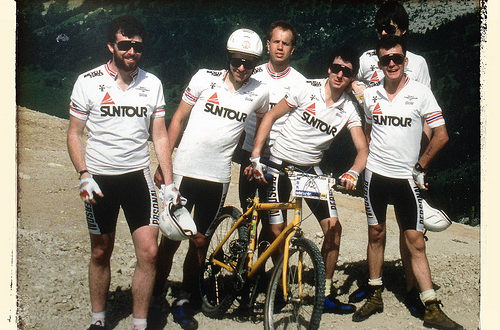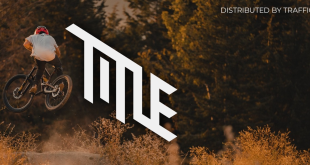Durango’s Mountain Bike Specialists is to celebrate its 50th birthday in March. The historic bike shop, founded in 1968 as The Outdoorsman before mountain biking was born, is having a birthday bash. If you can’t get to Colorado for the open house it’s possible to visit the store’s interior via Google StreetView. And if you do you’ll see, on the store’s back wall, a huge, hand-crafted banner. For many years this banner was missing. So what’s the story behind the theft – and later return – of this world championships banner?
+++
In the summer of 2012 mountain bike royalty gathered in the French ski resort of Villard de Lans to celebrate the staging of the 1987 Championnat Du Monde VTT. This was the first ever mountain bike world championships. Gary Fisher, Joe Breeze, Hans Rey, Scot Nicol, Jacquie Phelan, and Ned Overend joined French riders from back-in-the-day, such as Jacques Devi, to ride the original course (a tough, high-level route long since closed to mountain bikers) and to attend a gala dinner.
I was there for this reunion; I was there in 1987. Along with Peter Darke, a Sunderland bike shop owner, I had created the British Mountain Bike Team. Naturally, I picked myself to ride (I DNF’ed) but there were also real riders in the team, such as Jamie Carr and Orange founder Lester Noble. Here’s the story of the reunion, the 1987 event, the disappearance of the lovingly hand-made 1990 World Championship banner, thought to be long lost, and a 50-year-old bike shop that connects them all.
The banner made a mysterious reappearance at the reunion. Who had shimmied up a pole, in a Durango storm, to cut down the banner? And why did this brave soul give the banner to Mountain Bike Specialists?
+++
A touch to the left. Up a bit. Bit more. FTHWHACK!
I’ve done many stupid things in my life but quite why I stuck my fat head beneath an electrified fence to get a better shot of a bunch of riders will always be a mystery to me. It’s not as though I didn’t know the fence was electrified. Minutes before I had gingerly touched it to see if it was live. It was. I got a buzz, a quick tingle. When you flick an electric fence you’re expecting the buzz and, if you’re at all normal, you limit the exposure.
When you’re not expecting the shock, and it’s to the back of your head and you don’t know to flinch, things are a lot different. While crouching down low, and sticking my head and camera under the wire, I got a whomping whack of a shock. For a second I thought I’d been hit with a plank, assailant unknown.
I jumped, instinctively holding on to my camera with one hand, impulsively gripping the back of my head with the other.
Hank looked at me and, non-plussed, said: “I was waiting for that to happen.”
Thanks for the warning, Hank.
Hank as in Hank Barlow. The Hank Barlow who, in 1984, founded Mountain Bike, the first glossy US mountain bike magazine. He now lives in France but he’s an American. (Despite living in France for 20+ years his impeccable French is murdered by the most amazingly bad accent.)
He was not being my guardian angel in a farmer’s field above the town of Villard de Lans, in the Vercors region of France. He, and I, were by a dirt track, taking photos. Sensibly, Hank had positioned himself well away from the electric fence.
I had been able to fire off a few low angle shots before the whack to the head. The shots were of a group of old French guys, with spectacular ‘taches, clad in bulging day-glo Lycra, riding 1980s mountain bikes and sporting facial daubs of fluoro sunscreen.
The jolt had given me a fright, it hadn’t summoned a flashback, this wasn’t my memory playing tricks with me. The garish Lycra, the ancient bikes, the neon face paint, it was all part of an anniversary weekend organised in the summer of 2012 by Génération Mountain Bike, an MTB history organisation run by four enthusiastic French guys, still at school in the 1980s and who lusted after the high-end bikes of the day but couldn’t afford them. The 25 ans du 1er championnat du monde de VTT was Génération Mountain Bike’s celebration of the first ever mountain bike world championships. 31-years ago the ski town of Villard de Lans hosted hundreds of riders, on machines with cantilever brakes, no suspension forks, riding a severely technical course that involved almost as much carrying as riding.
The 1987 event was organised by Winning magazine. This was before the UCI got its sticky mitts on mountain biking. This was when there were still fag breaks during races, for some of the riders at least. Others were clearly starting to take it very seriously.
Mountain biking was growing up. But it was not yet professional, the sport was still in flux. In 1987 it was still possible to go on a bike holiday with your mates, call yourself the British Mountain Bike Team, and get away with it. And not just get away with it but blag loads of sponsorship, too. The team was headline sponsored by SunTour, with Rohan providing travel togs. Team jerseys were flock printed by Been Bag.
I was in Villard de Lans, partaking of impromptu electrotherapy to my scalp, because, back in the day, I had been the chief blagger. As the co-manager of the British Mountain Bike Team – the first such outfit – I had been able to pick myself to race alongside some of the top riders of the day. I also seeded the team with friends.
To my shame, I can’t remember the names of all on the team so don’t expect a full who’s who. Vince Edwards, I remember. He was the first placed bike rider in the 1987 Man v Horse v Bike races in Wales. Chris Hosking was a university mate of mine from Newcastle. He’s now the MTB trails specialist for the City of Prescott in Arizona and prior to that had worked on Mammoth Mountain in California, when the Kamikaze event was still being staged. Rob Orr was a baker. We’d met in Jesmond Dene, an urban woodland in Newcastle, surprising each other by seeing somebody else on a mountain bike: instant mates. Peter Darke was co-founder of the team. He had a bike shop in Sunderland; he still does, Darke Cycles. Shaun Rafferty was a mate of Peter’s. Jamie Carr was our youngest rider, and the most fearless, too. He now runs Ride the Alps, a mountain bike holiday company. Our best placed finisher (33rd or thereabouts) was Lester Noble. Yes, the Tushingham-riding windsurf champion who created the O-range of mountain bikes. Leaving his marque on the world he later ditched the hyphen.
In 1987 I was ostensibly at university, but a religious studies degree wasn’t terribly taxing so I was also a full-time journalist, one of two people working on one of the three UK bicycle magazines then in existence, none of which specialised in mountain bikes. Bicycle Times was a tinpot title produced on Tyneside, but it was available nationally in WH Smith’s. Publisher Peter Lumley introduced the world to Off Road Reid, my mountain bike stream of consciousness, a page that would be later transplanted into Bicycle Action, the mag owned by Muddy Fox (the original, market-shaping Muddy Fox), the mag that came before Mountain Biking UK.
(Off Road Reid’s bike testing reports were so bad they prompted John Stevenson, then working in Two Wheels Good of Leeds, to think “I could do better than that.” He could and he did. John was the tech editor of Tym Manley and Chris Turner’s MBUK, a magazine I feared would quickly flounder. Good at market predictions, me.)
Off Road Reid in Bicycle Action had a cartoon strip by Jo Burt. Mint Sauce, the mountain biking sheep, had first appeared in the newsletter of the Mountain Bike Club. (Jo Burt’s name was on my page elsewhere too. The page had a list of mountain bike contacts, folks you could ring up to arrange a ride. Jo Burt, who I didn’t know for Adam, lived in the Norwich house recently vacated by my sister. Small world.) The Mountain Bike Club was a NORBA-esque outfit run by journalist Max Glaskin and frame builder Jeremy Torr. In 1987 Torr hitched a ride in the Muddy Fox van and was one of the support crew at the first mountain bike world championships.
He remembers Villard de Lans, but wasn’t at the reunion (he now lives in Singapore). I didn’t remember the town, but was at the reunion. No amount of electrical stimulation could trigger recollections of Villard de Lans. Yet the course was memorable. So those that rode it second time around told me. I could only remember fragments of the 1987 trip.
Apparently, the British Mountain Bike Team flew to Geneva and hired a van. We rented a chalet. Don’t remember any of that. One evening Jamie Carr rode his bike down the concrete bobsleigh run. I took pictures of this feat, but have no memory of it.
In the race, I punctured. I had a flat before the race started and – I’ve since been told – it was a mad dash to get me ready for the off. I can imagine that, but don’t remember it. I partially remember shredding a tyre on a downhill section and DNFing.
Thanks to my slide collection (kids, get grandparents to explain what transparencies are) I can see that I photographed Ned Overend as he held his trophy aloft. I don’t remember the Muddy Fox team being there. From photos displayed in the pop-up MTB museum at the 25 year reunion I could see that Andy Pegg and Julia King were at the event, racing for Muddy Fox. Records show they were the best placed Brits, beating all in the ‘official’ team.
I can remember plenty of stuff from the 1980s but the first world champs remains, largely, a blur. This is therefore a tale of loss. Memory loss. But it’s also a tale of recovery. A banner was found, and a long lost racer was tracked down.
You’d think it would be pretty hard to lose a 12-metre wide race banner. But the organisers of the 1990 MTB World Championships, held on Purgatory Mountain, above Durango, Colorado, managed it. With the help of a fierce storm, that is. A prankster stayed on the mountain while others fled, and cut down the start banner. It was strung between 15-metre high poles. Designed by local artist Metja Swift, the banner was hand-stitched and proudly proclaimed the event to be the first ever mountain bike world championships sanctioned by the UCI.
This retrospectively made the Villard de Lans 1987 event into an unofficial world championships, ditto for the events held elsewhere in the world in 1988 and 1989 (there were World Championships staged in both Europe and the US in these two years).
Ed Zink, owner of Mountain Bike Specialists, and chairman of the race committee, was gutted about the theft, and kept alive hopes that the banner might one day reappear. Many attempts, over the years, were made to track down the thief and the banner, to no avail. The colourful, and historic, banner was, to all intents and purposes, lost.
Which is why its appearance in Villard de Lans in June 2012 was such a surprise. Gary Fisher, in town at the invitation of Génération Mountain Bike, tweeted that the 22-year-old mystery had been solved, the famous banner had reappeared.
The banner may have resurfaced, but the identity of the thief remained a mystery. Only Hans Rey could solve that. It was he who erected the banner at the reunion weekend, he who later spirited it away again as a gift to Zink, and he who knows the identity of the thief.
Rey wasn’t at the original event, but like Fisher, he was a guest of Génération Mountain Bike. The retro loving French foursome had also shipped in Joe Breeze, Scot Nichols, Ned Overend and Jacquie Phelan. Only Overend and Phelan had been at the original event.
Rey knew Durango native Overend was on the invite list and he figured that the reunion for the first world championships would be an appropriate venue for the lost banner to reappear. It was presented to Overend by Rey at the reunion’s ceremonial dinner. Rey said the banner had been stored, under lock and key, in Southern California, close to his Los Angeles home. He knew the identity of the prankster who had shimmied up the poles to cut down the banner, in a snowstorm, but, in public, he named no names.
Later that night, as Overend and Rey folded the banner into its storage bag, out of earshot of all others, I asked Rey if the thief was well known. He had a twinkle in his eye, but kept schtum.
The other rediscovery at the reunion weekend was MaryLee Atkins. Like the banner she, too, had been lost for more than 20 years. Lost to mountain biking, that is. She rode on the Schwinn team in the mid 1980s, the same team as Ned Overend (before he switched to Specialized, his current sponsor). She was the winner of the women’s race at the 1987 event. She then dropped out of the scene, retiring on a high. Nothing more was heard of her until Jacquie Phelan tracked her down.
Phelan is one of the key characters of early mountain biking, founder of WOMBATS (the Women’s Mountain Bike and Tea Society) and also, under her nom-de-plume of Alice B. Toeclips, a prolific writer. She’s married to Charlie Cunningham, the pioneering bike designer who championed aluminium long before the mainstream bike industry thought to do likewise. Cunningham – co-founder of Wilderness Trail Bikes, WTB – also designed the iconic Roller Cam Brake and co-designed Specialized’s famous Ground Control MTB tyre. Phelan used her hubby-designed bike and components to race as an equal with men. And horses: she was the first winner of the Man v Horse v Bike event of Llanwrtyd Wells.
She was second woman at the 1987 world championships. When Génération Mountain Bike invited her to the reunion she promised to track down MaryLee Atkins, the winner of the woman’s title in ’87.
Turning sleuth, she used old contacts books to track down friends of friends, before, finally, finding MaryLee’s bolt hole, in Eagle River, a small town in Alaska. She had been hard to track down because she had remarried and is now MaryLee Stiehrs. She and her carpenter husband run a bespoke wooden kitchen design business. For many years she didn’t ride. When girlfriends recently persuaded her to join them on a town loop on a borrowed beat up machine they couldn’t quite figure how she was so good and so fast. The first ever woman’s world champion mountain biker had kept her past to herself.
She’s now back in the saddle. She brought her original race-winning Schwinn to the reunion but for Alaskan trail riding she has a modern machine.
But let’s get back to that long-lost banner. It’s now displayed in Mountain Bike Specialists, and if you go to the shop’s birthday party you can see it up close.
The bike store – one of America’s best – also displays antique mountain bikes, including two hand-built mid-1980s Schwinns belonging to Durango local Overend, and Juli Furtado’s 1992 GT RTS-1. There are also race jerseys from Missy Giove and Greg Lemond.
The birthday bash will be held on March 1st.
+++
Parts of this article first appeared in Privateer magazine in 2013. Pic at top of article features Hans Rey, Ned Overend, Gary Fisher and Joe Breeze. More photographs can be found on Flickr.
 BikeBiz Bicycle and cycling retail news
BikeBiz Bicycle and cycling retail news




